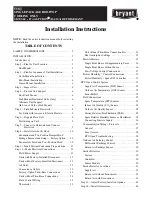
1 Application
Rittal cooling unit assembly and operating instructions
page
3
of
13
1
Application
Enclosure cooling units are designed and built to
dissipate heat from enclosures by cooling the air
inside the enclosure and protecting temperature
sensitive components.
2
Technical data
See nameplate
3
Assembly
The standard wall-mounted unit is suitable for exter-
nal mounting. Cut out the sections and drill accord-
ing to the drawing.
Cut the enclosed seals to the required length and
attach to the unit. Screw tapped pins into the blind
nuts on the rear of the unit. The unit is then to be
secured using washers and nuts
4
Safety notes
The following safety notices are to be observed in
their entirety for the correct use of the equipment:
To prevent the enclosure with the cooling unit
fitted tipping over, it is essential that this be
bolted to the floor.
A roller door is to be used to ensure problem
free opening and closing of the enclosure door.
A transportable enclosure with built-in cooling
unit may only be produced if an additional
transport anchorage to support the cooling unit
is used.
Prior to mounting, ensure that:
the site for the enclosure, and hence the ar-
rangement to the cooling unit, is selected so as
to ensure good ventilation;
the location is free from excessive dirt and mois-
ture,
the cutout for air extraction is located in the
upper area of the enclosure;
the mains connection ratings, as stated on the
rating plate. are available:
the ambient temperature does not exceed
+50°C;
The packaging shows no signs of damage.
Traces of oil on damaged packaging are an in-
dication of refrigerant loss and of leakage in the
unit system. Any damage to the packaging may
be the cause of subsequent malfunctions:
the
enclosure
is
sealed
on
an
sides
Condensation will occur if the enclosure is leaky;
the separation of the units from one another and
from the wall should not be less than 200mm;
air inlet and outlet are not obstructed on the
inside of the enclosure;
units are only fitted horizontally in the specified
position Max. deviation from the true horizontal:
2°
condensate drainage is provided
electrical connection and repair are carried out
only by authorized personnel
Use only original replacement parts and acces-
sories.
Losses from the components installed in the
enclosure must not exceed the specific refrige-
ration capacity of the cooling unit itself;
The customer may not modify the cooling unit in
any way.
5
Commencing operation and
control behavior
Following the completion of mounting and a waiting
period of approximately 30 minutes (to allow oil to
collect in the compressor in order to ensure lubrica-
tion and cooling).
5.1
Controller control
Figure 1: Controller
After electrical connection the internal fan turns on
and circulates the enclosure air. This helps assure
even temperature distribution within the enclosure.
The condenser fan and compressor are controlled
by the controller. The minimum time is 3 minutes to
restart the compressor after it has switched off. The
switching difference is 5 K. To avoid short switching
cycles and hence the danger of inadequate or only
partial cooling in some sections of the enclosure,
The switching difference should be set to be only as
low as necessary. For economic reasons (energy
saving), the nominal value of the internal enclosure
temperature Ti should also be set to be only as low
as necessary.
5.1.1
Operation of the controller
The display terminal H1 consists of a 3 position 7-
segment display which indicates the internal enclo-
sure temperature in °C as well as any fault codes.
The actual enclosure internal temperature is con-
stantly displayed on H1. When a system message is
generated, this alternates in the display with the
current internal enclosure temperature.















